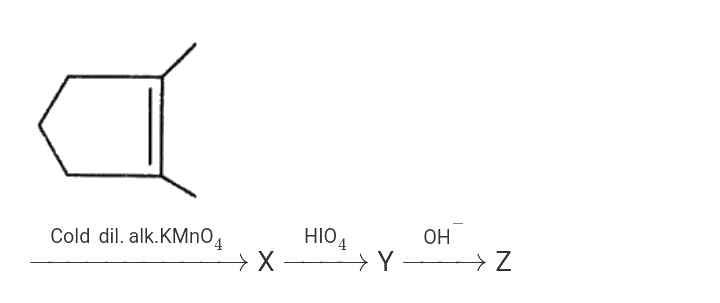CHCl3HNO3−−−→(X) In the above sequence , (X ) is :
Nitrochloromethane
Chloropicrin
Ethanenitrile
None of the above
The correct Answer is:B
To determine the compound (X) formed when chloroform (CHCl₃) reacts with nitric acid (HNO₃), we can follow these steps:
Step 1: Identify the Reactants
The reactants in this reaction are chloroform (CHCl₃) and nitric acid (HNO₃).
Step 2: Write the Structure of Chloroform
Chloroform can be represented structurally as:
Cl|H−C−Cl|Cl
This shows that chloroform has one hydrogen atom and three chlorine atoms attached to a carbon atom.
Step 3: Understand the Reaction Mechanism
When chloroform reacts with nitric acid, a substitution reaction occurs. The hydrogen atom from chloroform and the hydroxyl group (OH) from nitric acid combine to form water (H₂O), which is eliminated from the reaction.
Step 4: Identify the Product
The remaining structure after the elimination of water will have one of the chlorine atoms replaced by a nitro group (NO₂) from the nitric acid. The product formed is known as nitrochloroform or chloropicrin.
Step 5: Write the Structure of the Product
The structure of chloropicrin (or nitrochloroform) can be represented as:
Cl∣∣H−C−NO₂∣∣Cl
This indicates that one chlorine atom has been replaced by a nitro group.
Step 6: Conclusion
Thus, the compound (X) formed from the reaction of chloroform with nitric acid is chloropicrin.
Final Answer
(X) is chloropicrin.
---
The reactants in this reaction are chloroform (CHCl₃) and nitric acid (HNO₃).
Chloroform can be represented structurally as:
Cl|H−C−Cl|Cl
This shows that chloroform has one hydrogen atom and three chlorine atoms attached to a carbon atom.
When chloroform reacts with nitric acid, a substitution reaction occurs. The hydrogen atom from chloroform and the hydroxyl group (OH) from nitric acid combine to form water (H₂O), which is eliminated from the reaction.
The remaining structure after the elimination of water will have one of the chlorine atoms replaced by a nitro group (NO₂) from the nitric acid. The product formed is known as nitrochloroform or chloropicrin.
The structure of chloropicrin (or nitrochloroform) can be represented as:
Cl∣∣H−C−NO₂∣∣Cl
This indicates that one chlorine atom has been replaced by a nitro group.
Thus, the compound (X) formed from the reaction of chloroform with nitric acid is chloropicrin.
(X) is chloropicrin.
Topper's Solved these Questions
- ORGANIC COMPOUNDS WITH FUNCTIONAL GROUPBOOK - CENGAGE CHEMISTRY ENGLISHCHAPTER - ORGANIC COMPOUNDS WITH FUNCTIONAL GROUPEXERCISE - Exercises Assertion And Reasoning
9 Videos
- ORGANIC COMPOUNDS WITH FUNCTIONAL GROUPBOOK - CENGAGE CHEMISTRY ENGLISHCHAPTER - ORGANIC COMPOUNDS WITH FUNCTIONAL GROUPEXERCISE - Archives Single Correct
10 Videos
- ORGANIC COMPOUNDS WITH FUNCTIONAL GROUPBOOK - CENGAGE CHEMISTRY ENGLISHCHAPTER - ORGANIC COMPOUNDS WITH FUNCTIONAL GROUPEXERCISE - Exercises Multiple Correct
18 Videos
- NUCLEAR CHEMISTRYBOOK - CENGAGE CHEMISTRY ENGLISHCHAPTER - NUCLEAR CHEMISTRYEXERCISE - Archives Subjective
13 Videos
- P-BLOCK GROUP 15 ELEMENTS - THE NITROGEN FAMILYBOOK - CENGAGE CHEMISTRY ENGLISHCHAPTER - P-BLOCK GROUP 15 ELEMENTS - THE NITROGEN FAMILYEXERCISE - Exercises Archives (Subjective)
28 Videos
Similar Questions
Acetone HCN−−→(A)H3O+−−−→(B). In the above sequence of reaction A and B are :
View SolutionSO2+NO+H2O→X+ a dibasic acid XNaNH2−−−−→Y+H2O
In the above sequence, X and Y are respectively
View SolutionIsopropylamine KMnO4−−−−→XH+3O−−→Y
In the above sequence X and Y are
View Solution(CH3)2CONaCN−−−→HCI(A)H+3O−−→Δ(B)
In the above sequence of reactions, (A) and (B) are :
View SolutionH3C−C≡C−CH3Na/Liq.NH3−−−−−−−−→X In the above reaction X is
View SolutionC6H5−CH=CHCHO(X)−−→C6H5=CHCH2OH
In the above sequence (X) can be:
View SolutionSiCl4H2O−−→(X)heat−−→(Y)
In the above reaction (X) and (Y) respectively are :
View Solution
Cold dil.alk ,KMnO4−−−−−−−−−−−→XHlO4−−→OH−−−→Z
In the above sequence of reaction, Z is
View Solution(CH3)2CHOHMild−−−−−−→oxidation[O](X)(i)CH3Mgl−−−−−−−−→(ii)Hydrolysis(Y)
In the above sequence of reaction, (Y) is:
View SolutionSilver cyanide Δ−−→Silver+AOH−−−→X+Y+H2O In the above sequence of reaction A,X,Y are respectively.
View Solution
